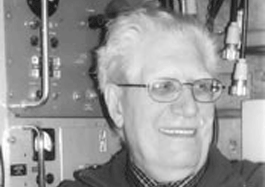GB2RS News for Sunday, 18 November 2012
Longest-serving GB2RS Newsreader becomes silent key
The Radio Society of Great Britain is saddened to report that its longest serving GB2RS Newsreader, Jimmy Porter, GI3GGY, died on Wednesday 7 November. He was 92 years of age and had spent the two previous weeks in hospital. Jimmy was an active member of the RSGB’s news broadcasting team until 2009/2010. He thus served in this capacity for some 55 years. In March 1954 he was asked by the RSGB Secretary, John Clarricoats, G6CL, to make a test AM voice transmission on 40 metres in order to assess the hoped-for UK coverage during daylight hours. Subsequently, the RSGB obtained permission from the GPO to broadcast GB2RS news on the 80m band. The first GB2RS news broadcast was actually made by Frank Hicks Arnold, G6MB, of Walton-on-Thames, on 25 September 1955. However, shortly afterwards the GPO gave permission for 40 metres to be used as well, and Jimmy commenced news reading each Sunday morning on 7047.5kHz. He employed an RCA ET4336 broadcast transmitter and a massive HF log periodic antenna for the purpose. Our thoughts are with his family at this difficult time.
Latest news on PLT
For over 15 years the RSGB has been active in standards work for powerline communications devices. The Society’s position opposing the latest proposals was presented to the UK BSI committee, supported by other members, but the UK voted in favour which, along with other EU national committees, caused the standard to be approved. What does this mean for UK radio amateurs? New devices must be certified to meet EN50561-2012, which gives significant protection to the amateur HF bands through fixed notching to the levels of the previous standard. It also requires a test to confirm dynamic power control, which reduces levels dependant on the insertion loss between the PLTs. Broadcast DX frequencies are outside the notch-protected bands and could suffer interference 10,000 times higher than previously. Intermodulation effects could also give rise to interference in the protected bands. We are starting a campaign to investigate and report all problems thought to be caused by these devices. We need your help, as only by proving that these devices cause real problems can we successfully lobby for modification to standard to reduce the permitted emissions. The small number of problems reported from the large population of these devices already installed in Europe swayed the vote on the standard. You can read more about this in the January 2013 RadCom and on the RSGB website.
New frequency for 5MHz Sunset Net
The popular Sunday evening 5MHz Sunset Net is changing frequency. The net, as its name implies, meets around UK sunset time on Sunday evenings to compare propagation with that during the 5MHz GB2RS News earlier the same day. It has for some time met on the UK’s 5371.5kHz channel. Following a number of reception reports from amateurs in the Republic of Ireland, the net participants have decided to move the Sunset Net’s frequency to 5398.5kHz, with a backup of 5278.5kHz, beginning today, 18 November, as both these latter two channels are available to EI amateurs. It is hoped that more EI amateurs with 5MHz experimental licensees will join the net in the future. They welcome all who wish to participate.
Also in GB2RS this week…
Russian taxi service on 21.4042MHz
A Russian taxi business from the Moscow area is using FM on 21.4042MHz daily. You can often hear a female voice organising the business. IARU Region 1 continues to monitor the situation and encourages all amateurs to continue to use the frequency as normal.
Mystery signals from China
Since October, mysterious Chinese signals on 7, 14, 21 and 21.010MHz have been heard. At first the A3E signals were sounding like a grunt or moo. These very strong multitone signals with a carrier and both sidebands have been heard every morning. The purpose is unknown, but IARU Region 1 encourages anyone who hears these signals to report them to the Intruder Watch service.
Category: GB2RS Headlines












